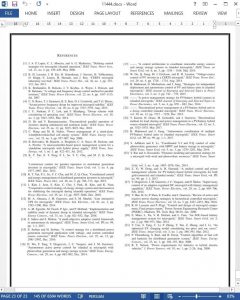Abstract
In this paper, a decentralized power management strategy is proposed for multiple photovoltaic (PV), battery, and droop units in an islanded microgrid. The control strategy is developed to handle any combination of these units without modifying their control systems. This provides a more comprehensive and generalized approach to coordinate the three types of units, in comparison to the techniques in the literature that consider only two types, mainly PV and battery systems, or consider only a single unit of each type. The operation of each unit is autonomously coordinated to maintain the balance between generation and consumption, while ensuring controlled charging/discharging of the batteries in the microgrid. To achieve this coordination, the voltage and the power control loops, within each of the PV and battery units, are configured to follow the specifically designed multi-segment power/frequency (P/f) characteristic curves. These characteristics are designed to independently adapt to the microgrid operating conditions, without relying on any external communications and centralized management systems. Accordingly, the control system for each unit is able to autonomously and seamlessly switch in real-time between power control and frequency regulation based on the available PV power, the state-of-charge of the batteries, and the total load demand in the microgrid. The strategy is designed and implemented using multi-loop controllers, in contrast to the commonly adopted approach of using discrete operating modes and switching logics. The proposed strategy is validated using a microgrid simulated in PSCAD/EMTDC with detailed switching models of the power electronic converters.
I. INTRODUCTION
THE intermittent nature of photovoltaic (PV) power generation poses a great challenge to the widespread adoption of PV systems in islanded microgrids. This necessitates the deployment of battery systems to complement the intermittent generation of PV units in order to maintain power balance in islanded microgrids. In other words, battery systems mimic the role the utility grid plays in grid-connected microgrids, to supply/absorb needed/surplus energy. However, battery systems have limited power ratings, limited capacities, and restricted charging scenarios that depend on the battery state-of-charge (SOC). Therefore, the operation of the PV and battery units must be coordinated to consider both the intermittent PV generation and the operating constraints of the battery units. Moreover, PV and battery units must be able to coordinate with dispatchable units that are commonly deployed to ensure continuity of supply. In islanded microgrids, these units typically employ the droop control strategies to achieve appropriate power sharing among the units [1]–[6].
IV. CONCLUSION
A decentralized power management strategy is developed in this paper to coordinate PV, battery, and droop controlled units in islanded microgrids. In this strategy, the local voltage and power control loops, at each of the PV and battery units, are configured to follow multi-segment P/f characteristic curves. These characteristic curves can be adjusted autonomously at each unit according to the microgrid operating conditions. It is shown that by using these adaptive P/f characteristic curves, a fully autonomous coordination can be achieved, without relying on any external communications and central management schemes. Also, it is shown that the multi-loop control implementation of the strategy results in smooth transitions among different control objectives. The performance of the proposed strategy has been successfully validated using a detailed switching model implemented in the PSCAD/EMTDC environment.











